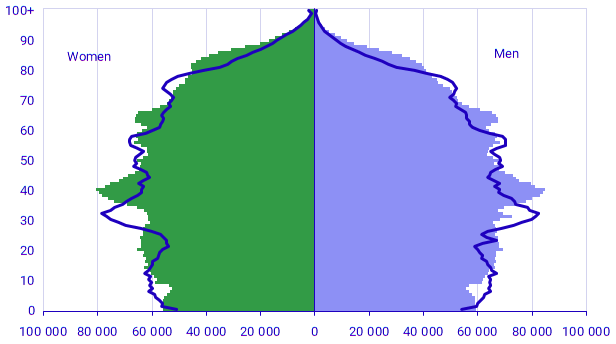The future population of Sweden 2023–2070
400 000 more people in Sweden in 2030
Statistical news from Statistics Sweden 2023-04-18 8.00
The size of different birth cohorts affects the future population. In the coming years the 1960s birth cohorts approach the retirement age, and the 1940s birth cohorts will pass the age of 80. Fewer children were born in 2022, and this will affect both childcare and schooling in the future.
Statistics Sweden publishes a projection of Sweden’s population every year. The projection is presented by age, sex and country of birth (native/foreign born) for each year in the period 2023—2070. Population projections are an important foundation for planning in areas such as government activities. Furthermore, these statistics are used as a basis for other statistics at Statistics Sweden that describe the future in Sweden.
By 2030, the population in Sweden is estimated to increase by approximately 400 000 and reach 10.9 million. Of this increase, approximately 300 000 is contributed by more people immigrating than emigrating, and 100 000 by more births than deaths.
More people immigrating than emigrating leads to an increase in the foreign-born population. It is estimated that in 2030 nearly 22 percent of the Swedish population will be foreign born. The share was 20 percent in 2022.

This diagram illustrates the population distribution in 2030 in the form of a population pyramid. The green area on the left shows the number of women of different ages and the light blue area on the right shows the number of men of different ages. The dark blue line displays the population in 2022.
Fewer children were born in 2022 compared to the previous few years, and the number of births in 2022 was by far the lowest since 2006. In 2030, these children will be 8 years old and have started school. This results in a smaller number of school children than today year by year with them ageing in the future. In 2030, those born around 1990 are entering their 40s and the 1960s birth cohorts have just reached the retirement age or will soon retire. In 2030, 67 years will be the stipulated retirement age to receive guaranteed pension according to the forecast of the Swedish Pensions Agency. The survivors of the 1940s birth cohort will by then be over 80 years old.
According to the projection, in 2030 there will be 810 000 people aged 80 or older, and they account for 7.4 percent of the population. Today just over 5 percent of the population are in these ages. It is estimated that more people in this age group will result in an increase in deaths by nearly 1 000 per year and the number of deaths in 2030 will reach just over 101 000.
With the retirement age to be raised from 65 years in 2022 to 67 years in 2030, the ages at which most people are expected to be gainfully employed are changing. The amount of population aged 25–66 years in 2030 is estimated to be 5 739 000, which is 380 000 more than the number aged 25–64 years in 2022. Simultaneously, the proportion of this working age population in the total population slightly increases. In 2022, people aged 25–64 years amount for 50.9 percent of the population. In 2030, people aged 25–66 years are estimated to amount for 52.5 percent of the population.
In the future, the population is expected to continue to increase, but at a slightly slower pace than in recent years. The population is estimated to reach 11 million in 2032. According to the projection, the inhabitants in Sweden are estimated to be 12 million in 2054 and 12.7 million in 2070, the last year in the projection.
Definitions and explanations
In the short term, this projection can be regarded as a population forecast. In the long term, the projection should be regarded precisely as a projection of the population in the case that the current behaviour and trends that we see today will continue in the future. Furthermore, an assumption is made that regulations that apply today will continue to apply throughout the projection period. Already in the short term, changes in society may mean that projection conditions will change. In the Tidö Agreement, an agreement which functions as the basis for the cooperation between the government parties and the Sweden Democrats, there are several proposals which, once introduced, could affect primarily the assumptions on migration. Decisions and legislative proposals made so far have been taken into account in this projection.
Publication
A more detailed report of this survey is published in (only in Swedish):
Statistical Database
More information is available in the Statistical Database
Feel free to use the facts from this statistical news but remember to state Source: Statistics Sweden.
